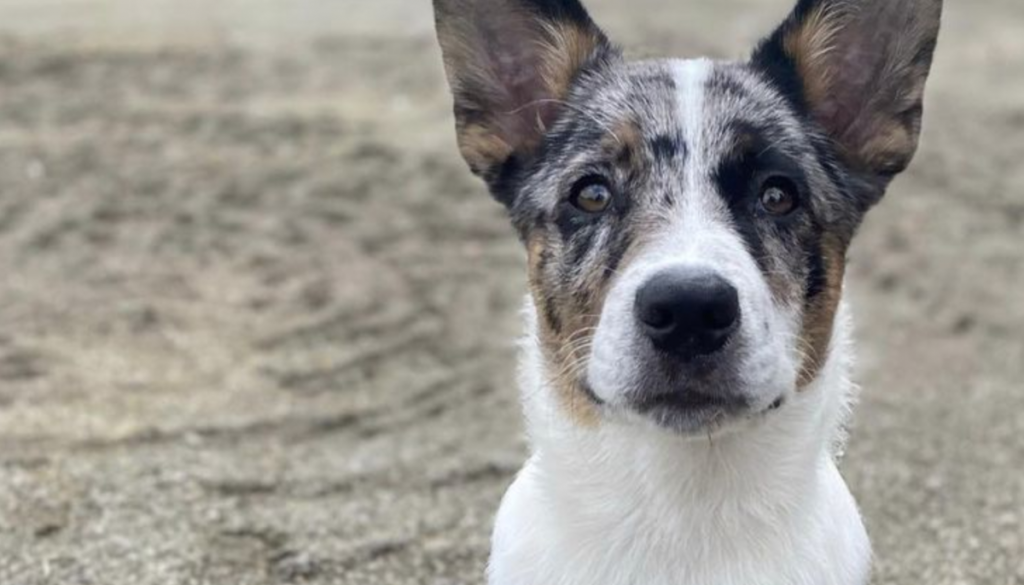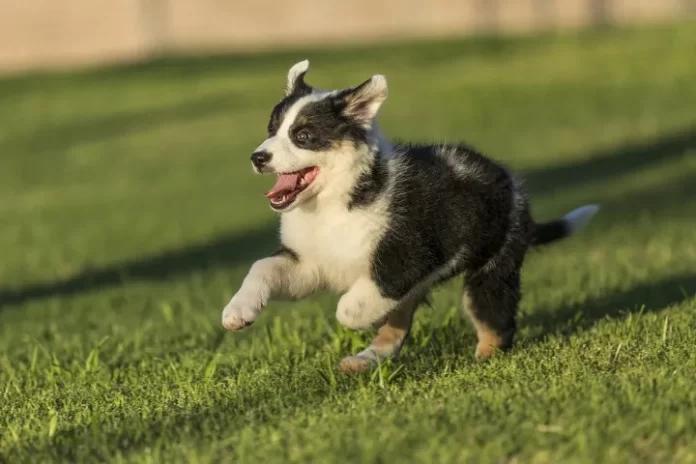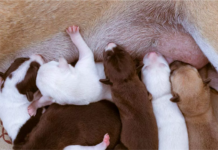Last Updated on October 18, 2023 by Fumipets
The Versatile Texas Heeler: A Bright and Energetic Hybrid Breed
The Texas Heeler is a unique and charming hybrid breed resulting from the crossbreeding of the Australian Cattle Dog and the Australian Shepherd. This breed combines the herding and working instincts of both parent breeds, making them intelligent, energetic, and highly trainable. Texas Heelers are known for their loyalty, versatility, and their ability to excel in various roles, from herding livestock to being a loving family companion.
Texas Heeler
| Height: | 16-22 inches |
| Weight: | 25-50 pounds |
| Lifespan: | 12-15 years |
| Colors: | Blue, black tan, white highlights |
| Suitable for: | Families with older children, ranchers, singles |
| Temperament: | Energetic, intelligent, loyal, protective |
The first Texas Heeler litter was born in 1970. An Australian Shepherd and an Australian Cattle Dog were the proud parents. Contrary to their Australian parents, Texas Heelers are hybrid dogs who are renowned for their herding prowess and boundless activity. They are also thought of as a totally American breed.
They make great herding dogs for farmers and ranchers because of their high IQs and desire to work hard for their masters. Although the pups are happiest managing herds of farm animals, suburban homeowners with vast backyards also like having them. Texas Heelers are excellent security dogs because they are devoted to their human owners.
Heelers may vary in appearance, but they retain the characteristics of their herding forebears. Some have long, straight tails from birth, while others are born with bobbed tails. Beautiful blue/gray with white flecks, tan and black, black and white, or other color combinations are just a few examples of the canines’ color patterns.
The majority of the dogs have short coats, but a few have lengthy hair that has to be groomed often. Texas Heelers are hardy creatures, but when their tongues are out, they also seem to be grinning. When their physical and nutritional demands are met, they form strong bonds with their owners and may live long, fulfilling lives.
3 Little-Known Facts About Texas Heelers
1. The Texas Heeler Is Not Recognized as an Official Breed
The Australian Cattle Dog father of the Texas Heeler may originate from either one of two canines, despite being a hybrid between an Australian Shepherd and an Australian Cattle Dog. Texas Heelers are bred from Original Cattle Dogs and Queensland Heelers, respectively. There is no defined breeding standard for the dogs since the parents’ lines have such a wide range of characteristics.
2. Texas Heeler Are Water Dogs
A Texas Heeler needs exercise to be healthy, so if you have a pool or pond on your property, the dog is likely to become a lifelong companion.
3. An Untrained Texas Heeler May Attempt to Herd Young Children
Despite their ability to be socialized with young children, Texas Heelers are simpler to manage with older youngsters. The dog won’t purposefully attack a youngster, but if it feels the need to herd the young person, it may knock the child to the ground.
Are These Dogs Good for Families?
If the dogs have ample space to roam on the property, Texas Healers make excellent pets for families of all sizes. Fortunately, dogs are simple to teach and won’t treat children like farm animals if they aren’t taught. Training in obedience may reduce their tendency to herd and make them more sociable with little people and even the household cat.
The Texas Heeler may not be the best choice for you if you and your family routinely take long vacations. They are very devoted and dislike spending extended periods of time alone. Texas Healers are challenging to board because they are suspicious of strangers. The dog won’t likely feel at ease being looked after by a stranger unless you have a neighbor that it adores. You should go for a smaller, less active dog if you live in a tiny flat.

Does This Breed Get Along with Other Pets?
Texas Heelers may live peacefully with another dog or cat with the right training. When you offer affection to the other animals, they could get envious and object. When they are young pups, they are more prone to welcome other animals and ultimately regard them as members of their own family. It’s preferable to feed all of your animals at the same time because of their innate protective tendencies. If you feed the Texas Heeler before the cat, the dog can disrupt the cat’s food. To prevent any interspecies confrontations, keep your food dishes in different areas.
Things to Know When Owning a Texas Heeler
Food & Diet Requirements
You must feed a dog that leads an active lifestyle and has a lot of energy protein-rich food from a reputable premium brand. To verify that the majority of the protein is derived from meat, look for products with at least 20% protein and carefully read the label. Plant proteins are safe for your dog, however food containing meat proteins is more similar to the diet that the animal’s ancestors would have consumed.
It is advisable to do your homework on each brand before choosing one since the pet food market is flooded with new vendors hoping to profit from a booming sector. Every month, there are recalls of pet foods and treats; to stay up to date on the most recent recalls, visit the FDA website. Texas Heelers need three to four cups of food divided into two meals every day. They need a lot of fresh water, therefore you will need to replenish the bowl at least twice a day unless you have a water bowl with a big reservoir.
Exercise
Exercise is essential to a Texas Heeler’s health, as was previously mentioned. A casual daily stroll will not be sufficient to meet the dog’s fitness needs. They are great running or trekking buddies and like running across wide meadows and fields. Texas Heelers need at least one and a half to two hours of exercise each day, and if they are unable to go outdoors, they may grow agitated and worried.
A Texas Heeler will exercise by running about a large backyard, but they’ll also demand you to join them. They are used to herding, therefore if you are unable to give sheep or goats for herding, you may play catch or run alongside one to keep them entertained. They want to please their humans, therefore playing alone is useless since it goes against a dog’s natural drive to work.
Training
The Texas Heeler is not one of the difficult to teach high-energy mixed breeds. They are incredibly intelligent and like picking up new skills and orders. You must choose if you want to change the dog’s herding characteristics before beginning training. When the owner lives on a ranch or farm, herding is the perfect attribute, but it may not be suited for households with many young children.
Texas Heelers adapt well to instruction, although they are resistant to punishment. In addition to being useless and cruel, hitting the pet or forcing it into a doggie pile on the carpet can damage the dog’s faith in you. Although they can seem energetic and difficult to control, they are simply happy to be with you and are always looking for new ways to let off steam. Use strong instructions without shouting, and if the dog successfully completes a job or consistently complies with a command, reward it with a tasty treat. A breed that appreciates training, like the Texas Heeler, makes the procedure much simpler. Patience is a characteristic that is essential throughout training.
Grooming
A short-haired Heeler requires little maintenance, but it still has to be brushed once a week. If you maintain a short-haired dog’s coat in a clean, clutter-free manner, you won’t require a dematter. To maintain the coat on a long-haired dog sleek and healthy, you should brush it at least twice a week or more.
The dog’s nails should be trimmed at least once every month since they grow quickly. Some Heelers become upset when you touch their paws, but you can demonstrate to your dog that the procedure is not frightening by asking a family member to help and giving goodies when the session is over. You may clean the canine’s teeth at least twice a week to minimize tartar buildup and infections. Use only dog-specific toothpaste, and ask your veterinarian for advice on how to brush your dog’s teeth properly.

Health and Conditions
Despite having a lifespan of 15 years or more, Texas Heelers are prone to numerous ailments and illnesses that afflict Australian Shepherds and Australian Cattle Dogs. Reduce your dog’s likelihood of getting a medical condition by feeding it a high-protein diet, taking care of its grooming, and exercising it often.
Minor Conditions
Hypothermia
Hereditary deafness
Cataracts,
Obesity
Serious Conditions
Hip/elbow dysplasia
Progressive retinal atrophy
Collie eye anomaly
Distichiasis
Osteochondritis dissecans
Male vs Female
There are no discernible behavioral differences between male and female Texas Heelers other than the fact that males are somewhat bigger and more muscular. However, when fixed at a young age, both male and female dogs are simpler to teach and manage.
Conclusion
The Texas Heeler is a magnificent animal that is brimming with personality and love for its owner, and it enjoys playing outside and always has a cheerful grin on its face. They are ideal for families and rural dwellers with plenty of acreage, but they are unsuitable for those who live in tiny apartments or who despise exercising with their dogs. Texas Heelers are devoted friends that don’t often bark needlessly but are quick to warn the family of danger and are ready to protect the house.
Although not everyone should own a working dog, the fortunate families who do are unlikely to find another breed that is as dependable and eager to serve its family.
https://www.youtube.com/watch?v=Cj3DOPgxVVc
Q&A: Texas Heeler
What is the origin of the Texas Heeler breed?
The Texas Heeler is a hybrid breed created by crossing the Australian Cattle Dog and the Australian Shepherd.
What are the typical characteristics of a Texas Heeler?
Texas Heelers are known for their intelligence, agility, and herding instincts. They often have a striking merle coat and are highly energetic.
Are Texas Heelers good for families with children?
Yes, Texas Heelers can make excellent family pets. They are loyal and protective, making them great with children.
Do Texas Heelers require a lot of exercise?
Yes, these dogs are highly energetic and require regular exercise and mental stimulation to stay happy and healthy.
What roles do Texas Heelers excel in?
Texas Heelers are versatile dogs that can excel in various roles, from herding livestock on a farm to participating in dog sports and being loving family companions.


















